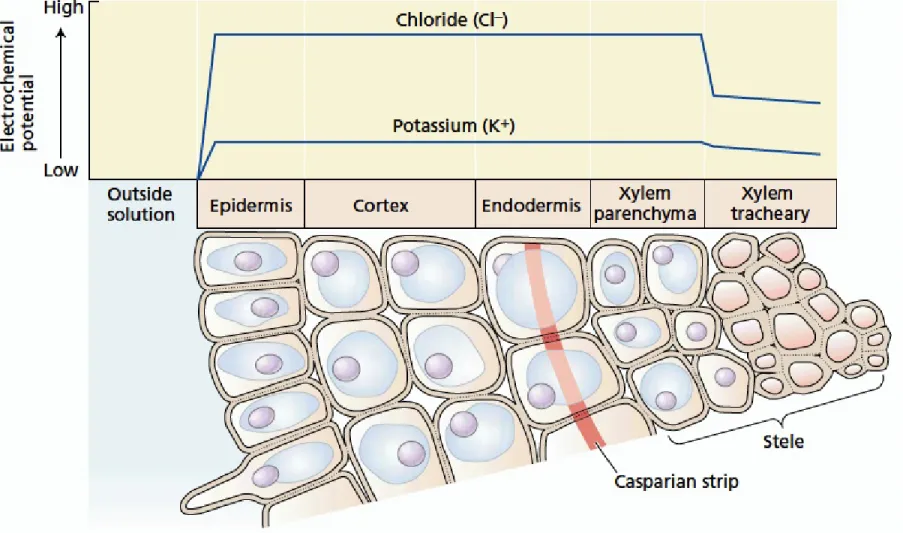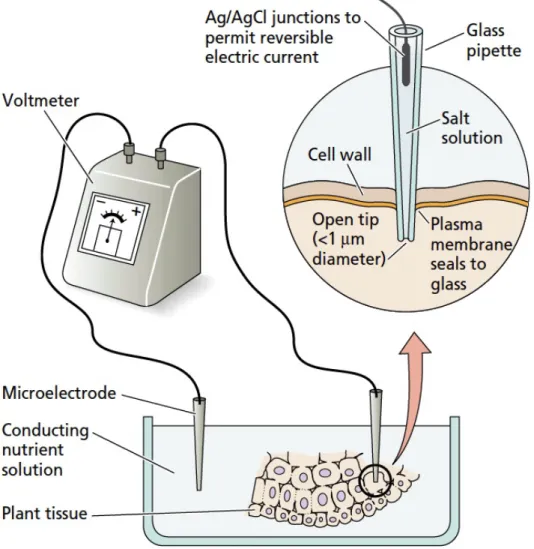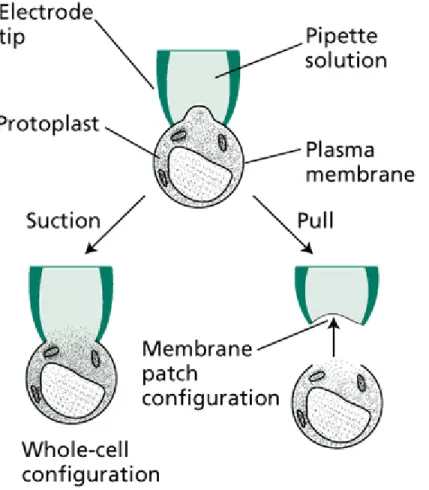PLANT PHYSIOLOGY
Nutrient uptake
Solute transport
Overview
1. Ion transport in roots
2. Passive and active transport
3. Membrane transport processes
4. Phloem transport
1. Ion transport in roots
1.1. Solutes move through both apoplast and symplast 1.2. Ions cross both symplast and apoplast
1.3. Xylem parenchima cells participate in xylem loading
Pathways for water and solute uptake by the root
Source: Taiz L., Zeiger E. (2002): Plant Physiology. p. 106.
Diagram showing electrochemical potentials of K+ and Cl– across a maize root
Plasmodesmata connect the cytoplasms of neighbouring cells facilitating cell-to-cell communication and solute transport
2. Passive and active transport
2.1. Concentration gradients and electrical-potential
gradients are integrated by the electrochemical potential 2.2. Movement of solutes across membranes down their free-energy gradient is called passive transport
mechanisms
2.3. Movement of solutes against their free-energy is known as active transport and requires energy input
2.4. The Nernst equation distinguishes between active and passive transport
Relationship between chemical potential and transport (passive, active) processes
Source: Taiz L., Zeiger E. (2010): Plant Physiology. p. 134.
Development of a diffusion potential and a charge separation between two compartments separated by a membrane
Diagram of a pair of microelectrodes used to measure membrane potentials across cell membranes
Diagram of the whole-cell and membrane patch configuration
Source: Taiz L., Zeiger E. (2010): Plant Physiology. Web material, http://5e.plantphys.net
Cyanide (CN-) blocks ATP production that leads to the collapse of the membrane potential
3. Membrane transport processes
3.1. Biological membranes contain specialized proteins that facilitate solute transport
3.2. Channels enhance diffusion across membranes 3.3. Carriers bind and transport specific substances
3.4. Primary active transport, called pumps, requires direct energy source
3.5. Secondary active transport uses stored energy
Three classes of membrane transport proteins:
channels, carriers, and pumps
Source: Taiz L., Zeiger E. (2010): Plant Physiology. p. 139.
Models of K+ channels in plants: (A) top view, and (B) side view of a channel
Carrier transport often shows enzyme kinetics, including saturation
Source: Taiz L., Zeiger E. (2010): Plant Physiology. p. 142.
Hypothetical model of secondary active transport
Two examples of secondary active transport coupled to a primary proton gradient
3. Membrane transport processes
3.6. Cations are transported by both cation channels and cation carriers
3.7. Anions are transported in the direction of passive efflux
3.8. Aquaporins forms water channels in membranes
3.9. Plasma membrane H+-ATPases are important for the regulation of cytoplasmic pH and for the control of cell turgor
Aquaporin activity is regulated by phosphorilation as well as by pH, calcium concentration, etc.
Source: Taiz L., Zeiger E. (2010): Plant Physiology. p. 150.
Hypothetical steps in the transport of a proton against its chemical gradient by H+-ATPase
Ion concentrations in the cytosol and the vacuole are controlled by passive (dashed arrows) and active (solid arrows) transport
Source: Taiz L., Zeiger E. (2010): Plant Physiology. p. 145.
Overview of the various transport proteins in the plasma membrane and tonoplast of plant cell
4. Phloem transport
4.1. Pathways of translocation
4.2. Materials translocated in the phloem
4.3. The pressure-flow model, a passive mechanism for phloem transport
4.4. Photosynthate distribution: allocation and partitioning
Source: Taiz L., Zeiger E. (2010): Plant Physiology. p. 272.
Transverse section of a 3-year-old stem of an ash (Fraxinus excelsior) tree
Schematic drawings of mature sieve elements:
(A) external view, (B) longitudinal section
Source: Taiz L., Zeiger E. (2010): Plant Physiology. p. 287.
ATP-dependent sucrose transport in sieve-element loading
Source: Taiz L., Zeiger E. (2010): Plant Physiology. p. 282.
Pressure-flow model of translocation in the phloem
A physical model of the pressure-flow hypothesis for translocation in the phloem
A simplified scheme for starch and sucrose synthesis during the day
Source: Taiz L., Zeiger E. (2010): Plant Physiology. p. 295.


